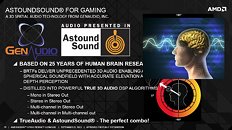- Joined
- Oct 9, 2007
- Messages
- 47,610 (7.45/day)
- Location
- Dublin, Ireland
| System Name | RBMK-1000 |
|---|---|
| Processor | AMD Ryzen 7 5700G |
| Motherboard | Gigabyte B550 AORUS Elite V2 |
| Cooling | DeepCool Gammax L240 V2 |
| Memory | 2x 16GB DDR4-3200 |
| Video Card(s) | Galax RTX 4070 Ti EX |
| Storage | Samsung 990 1TB |
| Display(s) | BenQ 1440p 60 Hz 27-inch |
| Case | Corsair Carbide 100R |
| Audio Device(s) | ASUS SupremeFX S1220A |
| Power Supply | Cooler Master MWE Gold 650W |
| Mouse | ASUS ROG Strix Impact |
| Keyboard | Gamdias Hermes E2 |
| Software | Windows 11 Pro |
At its press meet called to unveil its next-generation graphics lineup, which lasted for about 3 hours and 45 minutes, a full one hour was spent detailing TrueAudio, an audio DSP that AMD co-developed with GenAudio, makers of AstoundSound technology; both of which are brand names we'd heard for the first time, and that's coming from someone who's been an audiophile and follower of PC audio technology for 15 years now. Here are a few reasons why the concept of TrueAudio, or at least the way AMD and its newfound GenAudio pals explained it, is unconvincing to the extant of flagging "snake oil." While we did not attend GPU'14, experiencing TrueAudio is irrelevant to our analysis. It focuses on what "yet another" positional audio DSP has to do with GPU, and how AMD is getting ahead of itself with non-graphics features in exactly the same way it criticized NVIDIA of doing, not too long ago.



Back in the 1990s and the first half of the previous decade, discrete sound cards were an integral component of any self-respecting gaming PC, as onboard audio solutions were either too basic (ISA-based CODECs, USB-based AC'97) or sounded like greeting cards. Apart from higher fidelity, discrete sound cards offered proprietary positional-audio and DSP layers, promised hundreds of hardware-mixed audio voices, and what have you. AMD, in its presentation, didn't succeed in explaining how its solution is any different from something Dolby, Yamaha, Creative, ESS, and others haven't already tried.
With Intel's Azalia specification, and acceptable increments in audio fidelity past the 85 dBA signal-to-noise ratio mark with most motherboard-integrated audio solutions, game engine developers spent the better part of last decade innovating positional- and immersive- audio technologies that didn't require specialized hardware. You get the same incredible sound-effects on Battlefield 3 on any hardware, with discrete sound cards only offering better audio quality, but not better effects (positional- or realism). In that respect, we feel that it's quite arrogant of AMD to claim that there has been no innovation in PC game audio since programmable shaders (2001-02). To the contrary, game engine developers like Unreal, CryTek, DICE, etc., worked tirelessly to make effects comparable to three-figure discrete sound cards accessible to all gamers, by leveraging multi-core/multi-threaded CPUs.
What AMD didn't explain to us, is whether use of TrueAudio technology requires Radeon graphics cards to be installed; because if it does, then there's little difference between AMD's approach to positional-audio, and discrete sound card manufacturers', which unsuccessfully tried to make people to buy their sound cards on the "better audio immersion" plank, before switching over to the "better audio quality" plank, upon realizing that "better immersion" doesn't sell sound cards anymore.
What AMD also didn't explain is where "Radeon" fits into all this. It's a GPU alright, and combined with OpenCL, it's capable of general-purpose computing. It didn't explain whether the TrueAudio DSP layer runs on the CPU, or is something the GPU spares some of its computing power on. We're not convinced by the "hear more voices in a game" claim. The way audio is implemented on Windows, an application can stream up to 65,535 "voices" (independent streams of digital audio through a software/inter-process-communication channel), which are then mixed into "what you hear." So the only way AMD can sell "hear more voices," is if it gives developers something that can let them stream those hundreds of voices, while minimizing the CPU cost of processing and mixing them. If not having those many voices in any way steps beyond being just aesthetics (think crowds in a games like Assassins Creed, GTA), and actually affects the gameplay (i.e. not hearing all those voices puts you at a disadvantage in, say, an online multiplayer shooter), then you can bet your bottom penny that developers won't implement it.
In conclusion, even if TrueAudio made genuine improvements in the accuracy of positional audio, which they claim is backed by "25 years of brain research," there are too many factors stacked up against its successful proliferation. Want better sound? Go get a nice sound card and/or better speakers/headsets. Don't count on dinosaur DSPs anymore. There are two components to better game audio, "immersion" and "output quality." Your game developer already took care of the "immersion" part, and today's premium sound cards and speakers/headsets look after "output quality." Not much room for AMD to squeeze into this neat little arrangement.
View at TechPowerUp Main Site



Back in the 1990s and the first half of the previous decade, discrete sound cards were an integral component of any self-respecting gaming PC, as onboard audio solutions were either too basic (ISA-based CODECs, USB-based AC'97) or sounded like greeting cards. Apart from higher fidelity, discrete sound cards offered proprietary positional-audio and DSP layers, promised hundreds of hardware-mixed audio voices, and what have you. AMD, in its presentation, didn't succeed in explaining how its solution is any different from something Dolby, Yamaha, Creative, ESS, and others haven't already tried.
With Intel's Azalia specification, and acceptable increments in audio fidelity past the 85 dBA signal-to-noise ratio mark with most motherboard-integrated audio solutions, game engine developers spent the better part of last decade innovating positional- and immersive- audio technologies that didn't require specialized hardware. You get the same incredible sound-effects on Battlefield 3 on any hardware, with discrete sound cards only offering better audio quality, but not better effects (positional- or realism). In that respect, we feel that it's quite arrogant of AMD to claim that there has been no innovation in PC game audio since programmable shaders (2001-02). To the contrary, game engine developers like Unreal, CryTek, DICE, etc., worked tirelessly to make effects comparable to three-figure discrete sound cards accessible to all gamers, by leveraging multi-core/multi-threaded CPUs.
What AMD didn't explain to us, is whether use of TrueAudio technology requires Radeon graphics cards to be installed; because if it does, then there's little difference between AMD's approach to positional-audio, and discrete sound card manufacturers', which unsuccessfully tried to make people to buy their sound cards on the "better audio immersion" plank, before switching over to the "better audio quality" plank, upon realizing that "better immersion" doesn't sell sound cards anymore.
What AMD also didn't explain is where "Radeon" fits into all this. It's a GPU alright, and combined with OpenCL, it's capable of general-purpose computing. It didn't explain whether the TrueAudio DSP layer runs on the CPU, or is something the GPU spares some of its computing power on. We're not convinced by the "hear more voices in a game" claim. The way audio is implemented on Windows, an application can stream up to 65,535 "voices" (independent streams of digital audio through a software/inter-process-communication channel), which are then mixed into "what you hear." So the only way AMD can sell "hear more voices," is if it gives developers something that can let them stream those hundreds of voices, while minimizing the CPU cost of processing and mixing them. If not having those many voices in any way steps beyond being just aesthetics (think crowds in a games like Assassins Creed, GTA), and actually affects the gameplay (i.e. not hearing all those voices puts you at a disadvantage in, say, an online multiplayer shooter), then you can bet your bottom penny that developers won't implement it.
In conclusion, even if TrueAudio made genuine improvements in the accuracy of positional audio, which they claim is backed by "25 years of brain research," there are too many factors stacked up against its successful proliferation. Want better sound? Go get a nice sound card and/or better speakers/headsets. Don't count on dinosaur DSPs anymore. There are two components to better game audio, "immersion" and "output quality." Your game developer already took care of the "immersion" part, and today's premium sound cards and speakers/headsets look after "output quality." Not much room for AMD to squeeze into this neat little arrangement.
View at TechPowerUp Main Site
Last edited:





 , nice that you focus on sound though:shadedshu
, nice that you focus on sound though:shadedshu

 )
)


